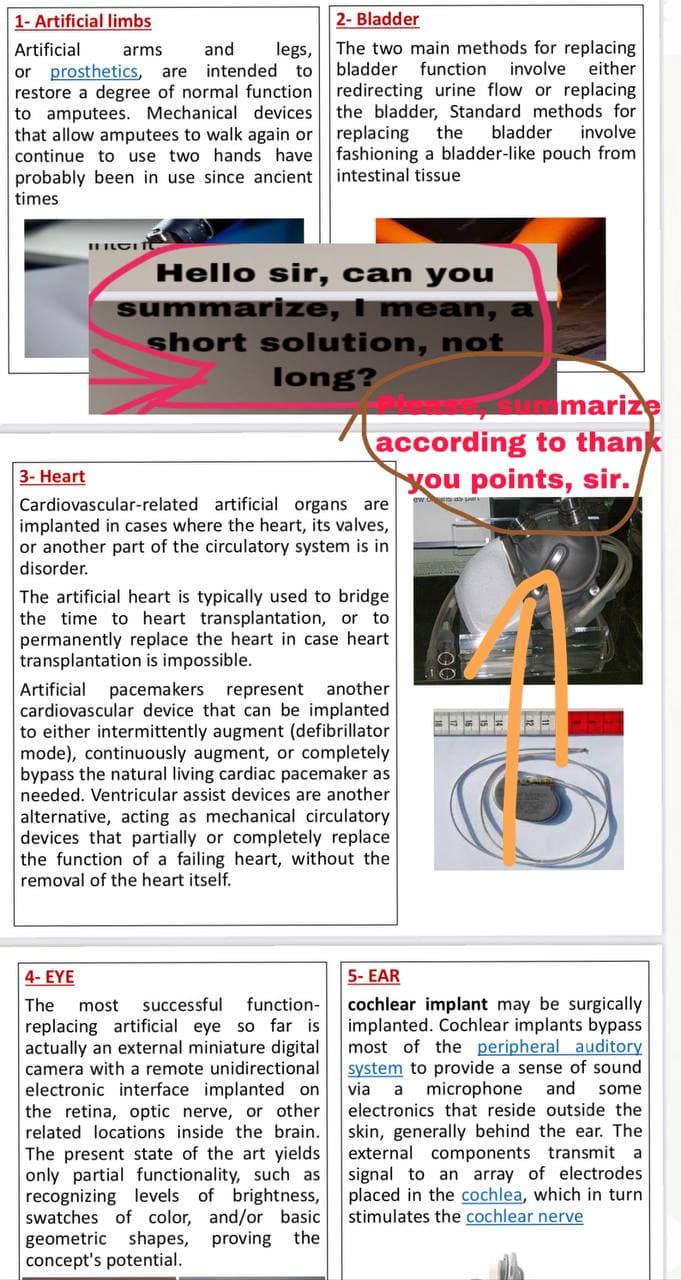Biology: The Dynamic Science (MindTap Course List)
4th Edition
ISBN:9781305389892
Author:Peter J. Russell, Paul E. Hertz, Beverly McMillan
Publisher:Peter J. Russell, Paul E. Hertz, Beverly McMillan
Chapter48: Regulating The Internal Environment
Section: Chapter Questions
Problem 7TYK: Which of the following is an example of autoregulation of kidney function? a. The RAAS regulates Na1...
Related questions
Question

Transcribed Image Text:1- Artificial limbs
2- Bladder
legs, The two main methods for replacing
function
Artificial
arms
and
involve
either
or prosthetics, are
restore a degree of normal function redirecting urine flow or replacing
to amputees. Mechanical devices
that allow amputees to walk again or
continue to use two hands have fashioning a bladder-like pouch from
probably been in use since ancient
intended to
bladder
the bladder, Standard methods for
the
bladder
replacing
involve
intestinal tissue
times
Hello sir, can you
summarize, I mean, a
short solution, not
long?
Imarize
according to thank
you points, sir.
3- Heart
Cardiovascular-related artificial organs are
implanted in cases where the heart, its valves,
or another part of the circulatory system is in
disorder.
The artificial heart is typically used to bridge
the time to heart transplantation, or to
permanently replace the heart in case heart
transplantation is impossible.
Artificial
cardiovascular device that can be implanted
to either intermittently augment (defibrillator
mode), continuously augment, or completely
bypass the natural living cardiac pacemaker as
needed. Ventricular assist devices are another
pacemakers represent another
alternative, acting as mechanical circulatory
devices that partially or completely replace
the function of a failing heart, without the
removal of the heart itself.
4- EYE
5- EAR
cochlear implant may be surgically
implanted. Cochlear implants bypass
most of the peripheral auditory
system to provide a sense of sound
via
electronics that reside outside the
The
most
successful
function-
replacing artificial eye so far is
actually an external miniature digital
camera with a remote unidirectional
electronic interface implanted on
the retina, optic nerve, or other
related locations inside the brain.
a
microphone
and some
The present state of the art yields
only partial functionality, such as
recognizing levels of brightness,
swatches of color, and/or basic
geometric shapes, proving the
concept's potential.
skin, generally behind the ear. The
external components transmit a
signal to an array of electrodes
placed in the cochlea, which in turn
stimulates the cochlear nerve
Expert Solution
This question has been solved!
Explore an expertly crafted, step-by-step solution for a thorough understanding of key concepts.
Step by step
Solved in 2 steps

Recommended textbooks for you

Biology: The Dynamic Science (MindTap Course List)
Biology
ISBN:
9781305389892
Author:
Peter J. Russell, Paul E. Hertz, Beverly McMillan
Publisher:
Cengage Learning

Biology: The Unity and Diversity of Life (MindTap…
Biology
ISBN:
9781337408332
Author:
Cecie Starr, Ralph Taggart, Christine Evers, Lisa Starr
Publisher:
Cengage Learning

Human Physiology: From Cells to Systems (MindTap …
Biology
ISBN:
9781285866932
Author:
Lauralee Sherwood
Publisher:
Cengage Learning

Biology: The Dynamic Science (MindTap Course List)
Biology
ISBN:
9781305389892
Author:
Peter J. Russell, Paul E. Hertz, Beverly McMillan
Publisher:
Cengage Learning

Biology: The Unity and Diversity of Life (MindTap…
Biology
ISBN:
9781337408332
Author:
Cecie Starr, Ralph Taggart, Christine Evers, Lisa Starr
Publisher:
Cengage Learning

Human Physiology: From Cells to Systems (MindTap …
Biology
ISBN:
9781285866932
Author:
Lauralee Sherwood
Publisher:
Cengage Learning

Biology: The Unity and Diversity of Life (MindTap…
Biology
ISBN:
9781305073951
Author:
Cecie Starr, Ralph Taggart, Christine Evers, Lisa Starr
Publisher:
Cengage Learning

Anatomy & Physiology
Biology
ISBN:
9781938168130
Author:
Kelly A. Young, James A. Wise, Peter DeSaix, Dean H. Kruse, Brandon Poe, Eddie Johnson, Jody E. Johnson, Oksana Korol, J. Gordon Betts, Mark Womble
Publisher:
OpenStax College

Biology 2e
Biology
ISBN:
9781947172517
Author:
Matthew Douglas, Jung Choi, Mary Ann Clark
Publisher:
OpenStax